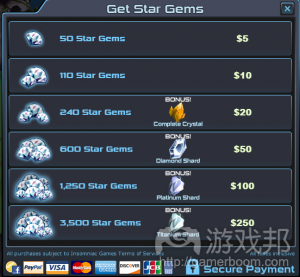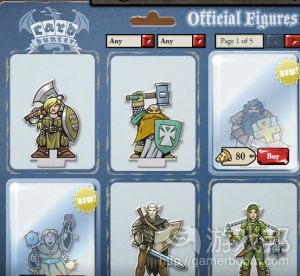分析移动 vs PC游戏的微交易心理
作者:Josh Bycer
微交易已经成为寻找游戏额外利润的开发者的一个主要战略,其中最热门的两大平台显然就是移动和PC市场。但是,虽然它们的出发点一样,但两者的微交易操作却大不相同,对于打算在这两个平台切换的游戏来说尤其有必要了解这两者之间的区别。
美元和美分
让我们先从移动市场开始。首先,我们在本文将忽略那些专用的手持电子游戏平台(3DS和Vita),因为使用这种设备与使用智能手机或平板电脑的心理并不相同。
大部分智能手机或平板电脑游戏玩家并不会专门为了玩游戏而购买设备。游戏只是这些设备上的一个次要功能,游戏设计师也深谙此道,并且会在设计手机游戏及为其定价时考虑到这一点。
当多数人玩手机游戏时,大家是为了获得一种快速体验,在排队等待过程中打发时间。虽然你可以连续数小时玩一款手机游戏,但其实际设计出发点也是快速体验,并非极富沉浸感的玩法。
因此,连续长期玩手机游戏极易让人疲惫不堪,但这里也有一个矛盾:为了最大化利润,设计师想让人们长时间但却不是延时玩游戏。
这正是节省时间、付费或等待、捷径等现象的盈利模式来源。通过使用付费或等待这类系统,设计师就可以在限制人们无需花钱玩游戏频率了。这样他们就可以降低那些付费用户的付出成本,让他们只花一美元左右的小钱享受数分钟的乐趣,这听起来是一桩不算糟的生意。
多数游戏围绕盈利性而创造,因为移动和社交游戏市场就是用那些可以通过多种调整而扩展的简单机制设计而成。这一市场允许设计师通过简单地调整数值,不断为前进中的玩家增添挑战或新内容。
所以在开始玩游戏的时候,玩家可能就要在回合或操作之间等待10秒左右,这最终会增加成等待数分钟,数小时甚至更多。
此时用户可能会因为失去耐心,转而选择花一美元继续游戏,这似乎是理所当然的。
但另一方面,设计师必须知道扩展玩游戏成本的范围,虽然售价100美元的付费货币是个值得投入的选项,但他们必须谨慎为游戏定价。自称应用是免费模式,之后又要求玩家花20美元解琐所有关卡,可能并不容易让人接受,在充斥大量99美分低价游戏的市场上更是如此。
用户留存是手机游戏开发的一大问题,也是我们在独立和其他平台的掌机游戏所看到的现象。针对智能手机创造长达80小时的RPG并收费20美元,并不适合一般用户。
首先,他们会因为这种价格而退避三舍,并且在一款游戏上花这么多时间还不如在多款游戏上享受一些速成的乐趣。从游戏销售情况来看,PC市场的情形与之十分相似,为如果大家能够花不到20美元的钱就获得同样多的乐趣,为什么要花60美元购买一款零售游戏?
虽然对移动市场来说,节省时间和快速消费是个很可行的宣传,但对硬核玩家来说,他们更青睐不同的选择。
持久战
手机游戏用户通常是为了打发时间而玩此类游戏,但PC玩家却有所不同。多数PC游戏玩家会腾出大量时间玩游戏,所以如果你年龄渐长,可能就会迫于工作和家庭的因素而只有一个小时左右的空暇时间。
对我来说,我一天会有一两个小时的游戏时间。尽管如此,人们坐在电脑前玩游戏时,却并不希望被告知自己已经不能再玩,只能等下回精力存满时再继续玩。
想象一下,如果暴雪在《魔兽世界》或《暗黑破坏神3》中植入一个付费或等待机制所招致的玩家抨击。对于PC玩家来说,一切都是投入,其用户也非常精明,了解你所采用的微交易模式的一切情况。
你可以试试通过设计或玩文字游戏迫使用户花钱,这类玩家肯定会大批流失。人们在PC游戏或F2P游戏上花钱时,他们就必须要知道自己的钱花在哪些值当的东西上。
手机游戏玩家可能会花一两美元短暂加速游戏进程,但高级玩家可不会这么好打发。他们必须要知道自己花出去的钱是否值当,而不只是为了花钱而花钱。
再次,你并不只是在与其他F2P游戏竞争一,而是与市场上所有的游戏交手,用户可选择的游戏太多了。
除此之外,这还意味着你能够开发那些标价较高的内容,只要它有价值,总有人会购买。
举个例子,《英雄联盟》中的付费皮肤售价可能高达20美元。如果在手机游戏中植入这种价格那么你一定是疯了,因为它并不含有与该平台相联系的购买冲动。但对沉浸其中并希望体现自己支持的PC玩家来说,他们就会购买。
换句话说,高质量的微交易总是优于以量取胜的小额微交易。让用户为回合或竞赛而不断掏钱这种模式,肯定会把PC游戏玩家都逼走。
更糟糕的一种做法就是,只给付费玩家一次获得自己想要之物的机会。我们在之前的文章就说过,一定要以清晰明确的态度对待PC游戏玩家。要让他们知道如果花了X美元,他们就可以得到Y物,而不是获得Y物的机会。
交易中的玄机
这涉及到用户花的钱可以让他们得到什么。如果某人在《英雄联盟》中花钱购买付费货币,他们显然很清楚这些货币的用途:新的champion,皮肤,符文等。这都不用猜,他们可以直接去商店购买商品。
移动和PC这两个平台都有鲸鱼用户:他们是极小比例,完全被游戏所吸引,并且几乎会购买所有东西的用户。
虽然他们有利于游戏创收,但却只是小部分群体,数量并不像一般用户那样庞大。创造一款明显瞄准鲸鱼用户的游戏,显然会驱使更多用户离开。
将一款F2P游戏或盈利型游戏从一个平台移植到另一平台,就需要格外注意游戏设计和微交易的交叉点。EA旗下的《植物大战僵尸2》就是一个例子,这款极重视微交易的游戏在PC平台上后来就更改了其盈利模式。
该游戏的微交易内容比之前更少,因此也更难获得回报。有些人怀疑EA此举是为了让游戏更吸引PC市场。
将手机游戏移植到PC市场,有一个问题可以决定其最终可行性:如果剥离所有的盈利元素,该游戏是否还有可玩性?
对许多手机游戏来说,它们有限的游戏设计和系统意味着它们并没有太多实质内容,这也正是微交易限制内容的原因所在。正如我们之前所言,人们很容易厌倦一款设计为长时间体验的手机游戏。
这也正是《英雄联盟》、《Card Hunter》、《Path of Exile》等游戏具有可行性的原因所在,因此它们无论有没有微交易模式都仍然是极具吸引力的游戏。如果游戏完全免费,这们也不会因此而分崩离析。
质量优先
最后,设计高质量的游戏是个重要因素,也是区分试图快速吸金与旨在开发优质体验这两种游戏的因素。
虽然让你的游戏赚钱是个重要目标,但衡量你的F2P游戏质量的标准则在于,你是否能够说服用户仅仅为了支持游戏而掏钱。
实现这一点并不容易,只有少数F2P游戏真正做到了,但对于追求像《英雄联盟》这种收益的设计师来说,这却正是令Riot Games获得成功的部分因素 ,也是任何想创造成功的F2P游戏之人需要考虑的重要因素。(本文为游戏邦/gamerboom.com编译,拒绝任何不保留版权的转载,如需转载请联系:游戏邦)
Mobile vs. PC and Microtransaction Psychology
by Josh Bycer
Microtransactions have become a major strategy for developers looking for additional profit with their games and the two most popular platforms are arguably the mobile and PC markets. However while their purpose is the same, microtransactions have a different impact and use on the two and it’s important to understand them, especially for games looking to make the jump between the two.
Dollars and Cents:
Let’s begin with the mobile market. First off, for this post we’re going to ignore dedicated handheld video game platforms (3DS and Vita), because the psychology of using one is different compared to that of a Smartphone or tablet.
The majority of consumers who use a Smartphone or tablet for games didn’t buy the device specifically for them. Instead, games are a secondary function and designers know that and take that into account when designing and pricing mobile games.
When most people play a mobile game, it’s supposed to be a quick experience, something to past the time when waiting on something or if you have a few minutes to kill. While you could play a mobile game for hours on end, the actual design is usually meant for quick bursts and not extremely engaging gameplay.
Because of that, it’s very easy for someone to get burnt out when playing a mobile game for a long duration, but there’s the paradox: To maximize profits, a designer wants someone to play a game for a long time but not for extended periods.
And this is where the monetization model of time savers, pay or wait, shortcuts, etc comes from. By using systems like pay or wait, the designer can limit how often someone can play a game without spending money. And they can make the cost small enough that for someone on the go, spending a dollar or so for a few minutes of enjoyment doesn’t sound like such a bad deal.
Most games built around monetization for both mobile and social markets are designed with simple mechanics that can be extended very easily through variable adjusting. Allowing a designer to keep adding challenges or new content by simply tweaking the values to go up and up as the player progresses.
F2P games aimed at the mobile or casual markets, based their monetization on premium currency or items with a limited duration.
So at the start of playing, the player may have to wait around 10 seconds between rounds or actions, this will eventually increase to waiting minutes, into hours or even more between actions.
And by that point, the person should be hooked enough that spending a dollar to keep playing would seem like a no-brainer.
On the flip side, designers have to know how far to stretch the cost of playing and while that $100 option for premium currency sounds like a sure investment, they need to be careful about how high they are actually pricing the game. Saying your app is free to play and then requiring a $20 purchase to unlock all the levels doesn’t sit well with people, especially when there are dozens if not hundreds of games for 99 cents waiting to take your customer away.
The problem with customer retention is one of the big issues with mobile development and why we’re not seeing the same level of scope with Indie and handheld games on other platforms. Building an 80 hour RPG for the Smartphone and charging $20 is just not going to work for the general consumer.
First, they’re going to be turned off by the initial investment and to spend all that time on one game where there are others for quick enjoyment sounds like a better deal. This is actually a similar situation we’re seeing on the PC thanks to game sales, as why should someone spend $60 on a retail game when they can get as much enjoyment or more out of a $20 or less indie title?
While advertising saving time and quick purchases works for the mobile market, among hardcore gamers, we have a different option on the matter.
The Long Haul:
While someone who plays mobile games generally play them when they have time to kill, a PC gamer is a bit different. Most PC gamers budget their time to play games in chunks of time; all the more so when you’re older and you may only have an hour here and there thanks to work and family.
For me, I budget my time to play a game for like an hour or two a day and then that’s it for the rest of the day or even couple of days. Regardless, when someone sits down to play a game on the computer, they don’t want to be told that they can’t play now and come back when your energy is restored.
Try to imagine the backlash if Blizzard ever put a pay or wait mechanic in WOW or Diablo 3. For a PC gamer, everything is an investment and the audience is savvy enough to understand everything about your microtransactions.
Try to trick or force someone into spending money either through design or confusing wording and they will leave in droves. When someone spends money on a PC game, F2P or otherwise, they need to know that their money is going towards something worthwhile.
While a mobile gamer may be find throwing a dollar or two to speed things up or for a short term boost, educated gamers aren’t going to be so giving. They need to see something worth spending money on and not just spending money on currency for currency sake.
Creating items that have a permanent effect or personalization is a great way of adding value to microtransaction purchases.
Again, you’re not just competing with other F2P games but every game that is available and there are a lot to choose from.
On the plus side, it means that you can afford to develop content that can be priced higher as if the value is there, then someone will purchase it.
Case in point are the premium skins for League of Legends which can go for $20 a pop. Having a purchase like that on a mobile device would be crazy as you lose the impulse buy associated with the platform. But for a PC gamer invested and wanting to show their support, they will pony up for it.
To put it another way, it’s better to have quality microtransactions as opposed to quantity with small and frequent ones. One thing that is sure to drive PC gamers away is saying that in order to play they need to keep spending money in between matches or play.
Or worse, saying that spending money only gives the player a chance at getting something they want. As we’ve talked about in earlier posts, you need to be as explicit as possible with PC gamers. They need to know that if they spend X then they are going to get Y, not a chance to get Y.
What’s in the Purchase?
It’s all about the dollars and cents and what they will get someone. If someone spends money on premium currency in League of Legends, they know exactly what it can be used for: New champions, skins, boosts and rune pages. There’s no guesswork involved, it’s akin to going the store and buying a product.
Now I know that with both platforms there are the whales: The small percentage of people who become completely hooked and will buy almost everything.
And while they are great for profit, they are the minority and not the same as the general consumer of your game. Building a game to explicitly target whales with microtransactions is sure to drive more people away then pull them in.
Trying to move a F2P or monetized game from one platform to the other requires a careful eye to how the design of the game and microtransactions intersect. A lesson that EA is apparently following, as reports are saying that Plants vs. Zombies 2, the heavily microtransaction sequel to the PC game has been updated with a change to its model.
The game has less microtransactions than before with a higher difficulty to compensate. Some people are speculating that this is to make the game more appealing to the PC market when the game is hopefully released there soon.
When moving a mobile game to the PC market, ultimately there is one question that needs to be answered to determine its viability: If all the monetized elements were stripped out, would the game still be worth playing?
For many mobile games, their limited game designs and systems mean that there just isn’t a lot there and this is why the microtransactions gate the content. And as we’ve talked about, playing a mobile designed game for long periods of time is a surefire way to get burnt out on it.
This is the reason why games like League of Legends, Card Hunter, Path of Exile etc work, because at the end of the day they are still engaging titles with or without their microtransactions. And none of them would break down if the game all of a sudden became completely free.
Quality Comes First:
Remember, you don’t need to create game breaking purchases to attract people, as long as they’re getting something of value for their money spent is fine.
In the end, designing a quality game first is the big factor and what separates games that are out to make a quick buck vs. those that are being developed for a quality experience.
While earning money for your game is an important goal, the real measure of the quality of your f2p game is if you can convince people to spend money for simply supporting your game.
It’s not easy to do and there are only a few F2P games that have achieved that, but for the designers chasing the profits of League of Legends, it is part of what has made Riot Games a success and an important consideration for anyone attempting to make a successful F2P game.(source:gamasutra)
上一篇:从主机转向移动游戏的美术设计经验
下一篇:应用开发者为何应该了解目标用户










































 闽公网安备35020302001549号
闽公网安备35020302001549号